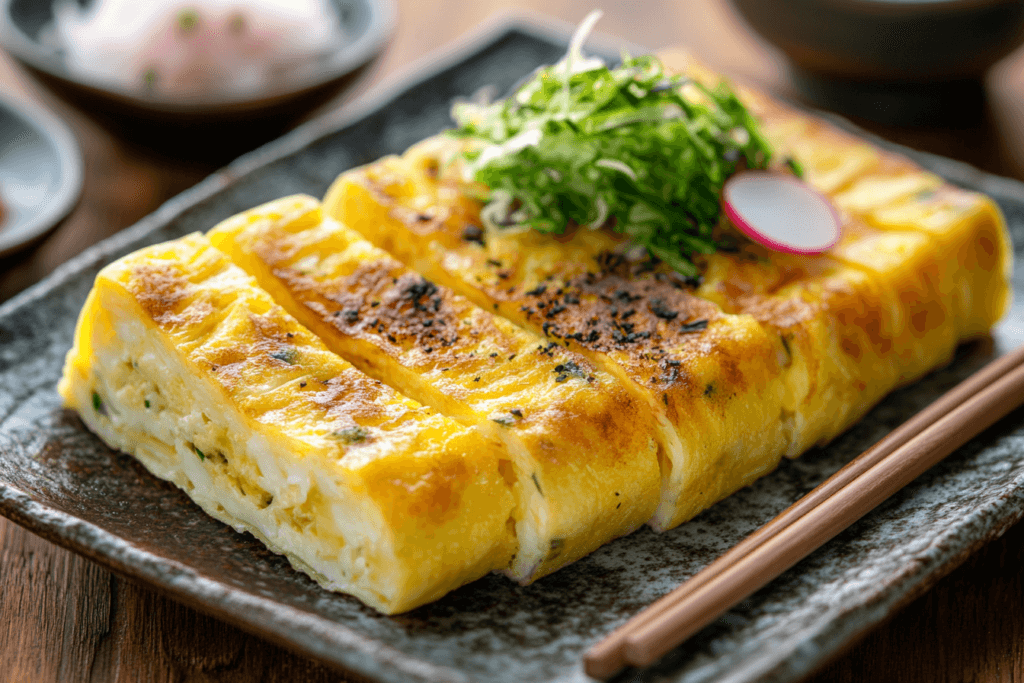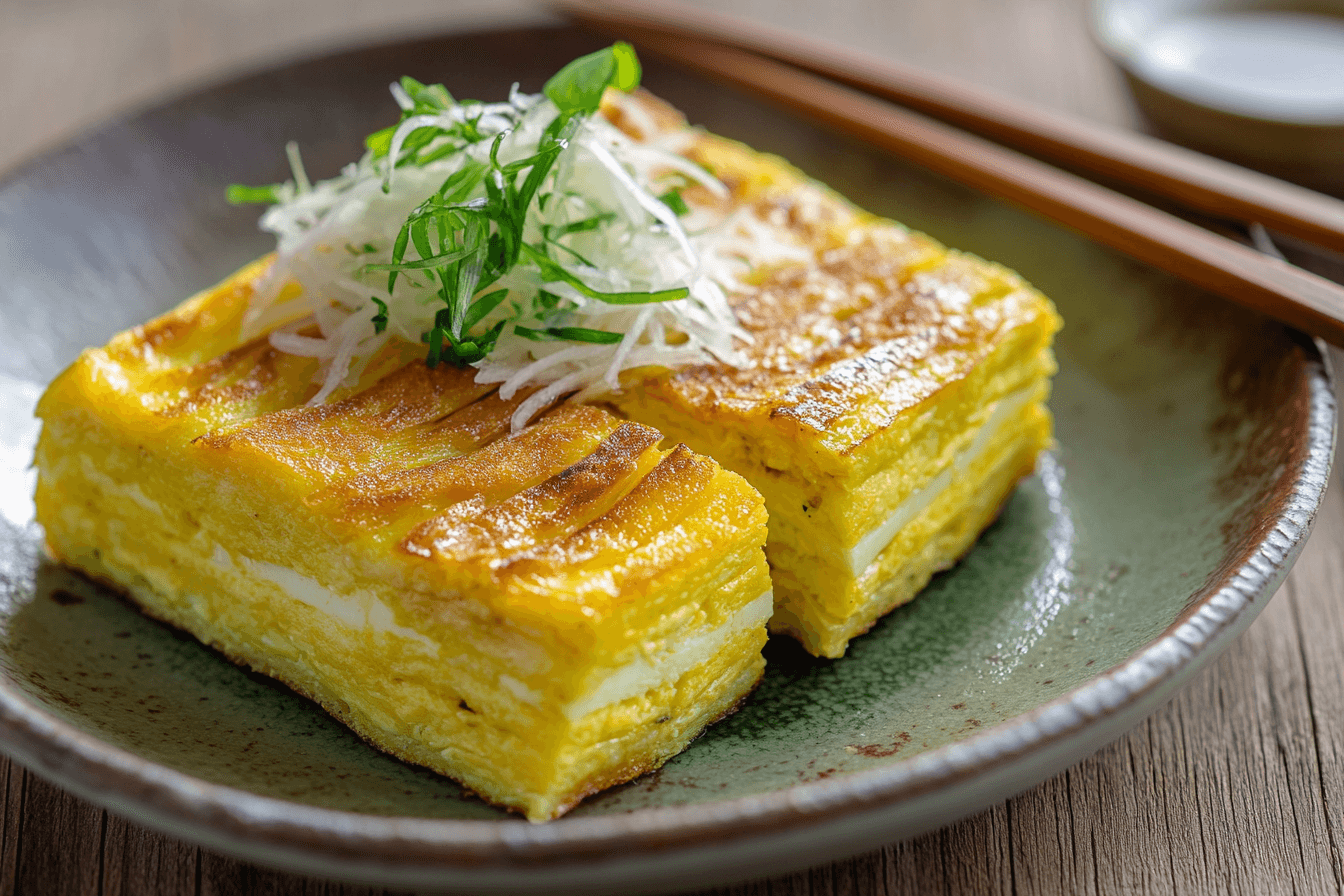Start your day with a delicate, flavorful Japanese rolled omelette, or tamagoyaki. This dish is a big part of Japanese cuisine. It’s not just tasty; it also shows Japanese culture and hospitality.
To make tamagoyaki, you need eggs, dashi stock, and soy sauce. You’ll also need a special tamagoyaki pan. It’s easy to make at home with just 6 ingredients and under 15 minutes of prep time. Whether you’re a pro or just starting, making tamagoyaki is a fun way to learn about Japanese culture.
Table of Contents
The Art and History of Tamagoyaki
Learning how to make tamagoyaki means diving into its rich history and cultural importance. This traditional Japanese dish has a tamagoyaki recipe from the Edo period. It has grown, adding new ingredients and cooking methods over time. The basic tamagoyaki recipe uses eggs, dashi stock, and soy sauce. These are mixed and cooked in a special tamagoyaki pan to get the signature roll.
Making tamagoyaki is more than following a tamagoyaki recipe. It’s about mastering the art of rolling the omelette. This needs patience, skill, and the right tools, like a tamagoyaki pan. This pan’s unique shape and non-stick surface help roll the omelette perfectly.

Exploring tamagoyaki reveals many regional styles and flavors. From Tokyo’s sweet style to Kyoto’s savory, there’s a tamagoyaki recipe for everyone. Whether you’re new or experienced, making tamagoyaki is a journey that celebrates this traditional dish’s beauty and simplicity.
When making tamagoyaki, remember a few key tips. Use the right pan, keep the heat low, and don’t overfill the pan. With practice, you’ll make delicious and beautiful tamagoyaki that will wow your loved ones. So, why not try it and discover the art and history of tamagoyaki yourself?
Essential Equipment for Perfect Tamagoyaki
To make perfect tamagoyaki, you need the right tools. A good tamagoyaki pan is key. It cooks evenly and helps roll the eggs into shape. Look for a pan that’s made of good material, the right size, and has a non-stick coating.
Some top picks include the Iwachu Iron Tamagoyaki Omelette Pan and the Young & Dangerous Copper Tamagoyaki Pan.
Here are some key features to look for in a best tamagoyaki pan:
- Material: Copper, cast iron, and aluminum are popular options, with copper being the most effective for heat conduction.
- Size: A rectangular pan is recommended for achieving the desired tamagoyaki shape.
- Non-stick coating: A non-stick coating can make cooking and cleaning easier, but it may not be necessary if you’re using a well-seasoned cast iron pan.
You’ll also need basic kitchen tools like chopsticks and a spatula. With the right equipment and tamagoyaki ingredients, you’ll be well on your way to making perfect tamagoyaki.

Some popular tamagoyaki pans include the ROCKURWOK Nonstick Tamagoyaki Pan and the TIKUSAN Japanese Tamagoyaki Omelet Copper Pan. Prices for tamagoyaki pans can range from around $18.99 to $84.99, depending on the material and size.
Understanding Your Ingredients
To make the best tamagoyaki, you need top-notch ingredients. A classic tamagoyaki recipe calls for eggs, dashi stock, soy sauce, and salt. Each ingredient plays a key role in the dish’s taste and texture.
Dashi stock brings a savory flavor, while soy sauce adds depth and umami. These elements are crucial for a great tamagoyaki.
The balance of sweet and savory is key in tamagoyaki seasoning. In Japan’s Kanto region, tamagoyaki is sweeter due to more sugar. The Kansai region, however, prefers a savory taste with more dashi and salt. You can adjust the sugar and soy sauce to your liking.
Here’s the nutritional info for tamagoyaki:
| Nutrient | Amount per slice |
|---|---|
| Calories | 89 |
| Carbohydrates | 13.6g |
| Protein | 3.8g |
| Fat | 2.5g |
| Sodium | 664mg |
Knowing your ingredients is key to making delicious tamagoyaki. Whether you’re following a tutorial or trying new flavors, focus on quality and balance.
Mastering the Basic Tamagoyaki Technique
To make a tasty traditional tamagoyaki, you need to learn the basic steps. It’s all about cooking eggs right and rolling them into a perfect shape. The secret is to get the eggs just right, with the right heat and moisture.
For traditional tamagoyaki, you’ll use a special rectangular pan. It’s coated with oil to stop eggs from sticking. The heat is medium, so the eggs cook slowly and evenly. Then, you roll the eggs into a shape that’s typical of tamagoyaki.
Here are some key steps to follow when making traditional tamagoyaki:
- Use a ratio of 1:1 dashi stock to egg for a custardy texture
- Add 1 teaspoon of potato starch to help bind the dashi stock with the egg
- Use 1 teaspoon of usukuchi soy sauce for a delicate flavor profile
- Add ⅛ teaspoon of salt for seasoning
By following these steps and practicing, you can make a delicious Japanese egg omelette. Be patient and gentle when rolling the tamagoyaki. This will help you get a smooth texture. With time and effort, you’ll get the hang of it and enjoy this traditional Japanese dish.
| Ingredient | Quantity |
|---|---|
| Dashi stock | ¾ cup |
| Eggs | 4 large eggs |
| Potato starch | 1 teaspoon |
| Usukuchi soy sauce | 1 teaspoon |
| Salt | ⅛ teaspoon |
Step-by-Step Rolling Method
To make perfect tamagoyaki, you need to learn the rolling method. This method involves rolling thin layers of egg mixture. Each layer is cooked until it sets before adding the next one. Preparing the egg mixture is key, needing a mix of ingredients for the right taste and texture. The mix should have 4 large eggs, 3 tablespoons of dashi soup stock, and 1 1/2 to 2 tablespoons of sugar.
When rolling, use a tamagoyaki pan and a gentle motion. This creates the tamagoyaki’s unique shape. You can also add ingredients like cheese, vegetables, or seaweed to the egg mix. Here are some tips to keep in mind:
- Use medium heat for beginners, and medium-high or high heat for proficient cooks.
- Roll the tamagoyaki three times, using about 1/3, 1/2, and then the remaining mixture.
- Let the rolled tamagoyaki sit for about 3 minutes to allow residual heat to continue cooking.
By following these steps and practicing the rolling method, you’ll make delicious tamagoyaki. Remember to try different tamagoyaki variations to find your favorite flavors and ingredients.
Advanced Tips for Professional-Looking Results
To get professional-looking tamagoyaki, you need to learn advanced tamagoyaki techniques. The right pan is key for even cooking and the perfect roll. The pan’s material and size matter a lot.
For tamagoyaki presentation, fillings and garnishes make a big difference. Try seasonal fruits or cheese for a tasty twist. A great presentation balances flavors and textures, making each bite special.
- Using a copper Tamagoyaki pan for excellent heat conductivity
- Adding a dash of soy sauce or sugar to enhance the flavor
- Creating a perfect roll by gently and smoothly tilting the pan
By using these advanced tamagoyaki techniques, your tamagoyaki will impress everyone. Remember, practice is key. Don’t be afraid to try new things to get the perfecttamagoyaki presentation.
Creative Tamagoyaki Variations
Once you get the hang of making tamagoyaki, it’s time to try new recipes. You can add flavor and texture by using different fillings. Try vegetables, meats, or cheeses for a tasty mix.
Popular fillings include mushrooms, spinach, and crab meat. For a spicy twist, add spicy sauces or wasabi. The goal is to mix flavors and textures for a great taste.
Be creative with the eggs you use too. Try quail eggs or duck eggs for a unique taste. Also, experiment with grilling or pan-frying for extra crunch.
Here are some tips for making your own tamagoyaki variations:
- Try different fillings and ingredients to find your favorites
- Be adventurous with ingredients like truffles or caviar
- Focus on balancing flavors and textures
- Have fun and be creative – there are endless possibilities!
Serving and Presentation Ideas
When serving tamagoyaki, how you present it matters a lot. In Japanese cuisine, the presentation can make a big difference. Use small plates and chopsticks for a traditional look. You can also add garnishes and sauces for a modern touch.
A beautifully presented tamagoyaki can impress your guests. Try using edible flowers or microgreens as garnishes. Serving it with soy sauce or wasabi can also add flavor. Think about the colors and textures you use to make the dish appealing.
In Japanese cuisine, tamagoyaki is often part of a bento box. To make a great bento, mix colors and textures. Include pickled vegetables, fresh fruit, and whole grains. This makes your meal interesting and visually appealing.
Here are some ways to serve tamagoyaki:
- As a side dish, with steamed veggies or a salad
- In a bento box, with other Japanese dishes
- As a snack, with dipping sauce or wasabi
Try different presentation ideas to find the best way to enjoy your tamagoyaki. This way, you can make your meal both delicious and visually stunning.
Conclusion: Your Journey to Tamagoyaki Mastery
Your journey to mastering tamagoyaki has been a flavorful exploration. You’ve learned to make the perfect Japanese egg omelette. It’s not just about following steps, but also about embracing the art and adding your own touch.
Remember, patience and persistence are key. It may take 10 to 15 attempts to get it right. But with each try, you’ll learn more and appreciate this dish even more.
The world of Japanese cuisine is vast and captivating. Mastering tamagoyaki is just the start. Dive deeper into the rich flavors and traditions of Japanese food. With your tamagoyaki expertise, you’re ready for more culinary adventures. Let your passion for cooking guide you. Craving more mouthwatering, fast, and effortless recipes? 🍽️✨ Unlock a world of irresistible flavors at recipesquick.net and transform every meal into a delight!


